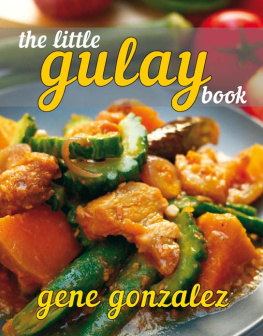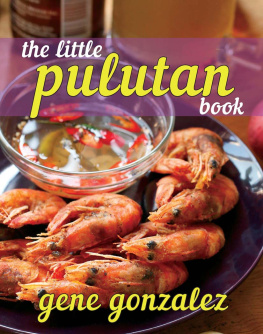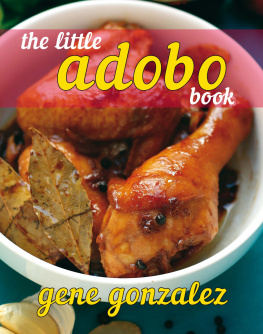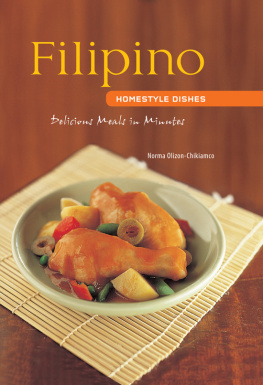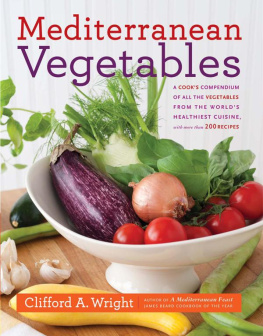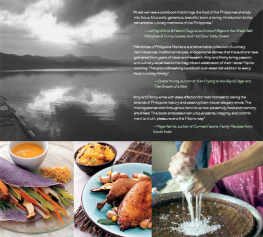The Little Gulay Book
Gene Gonzalez
Copyright to this digital edition 2015 by GENE GONZALEZ
All rights reserved. No part of this book may be reproduced in any form or
by any means without the written permission of the copyright owner and
the publisher.
Published and exclusively distributed by
ANVIL PUBLISHING INC.
7th Floor Quad Alpha Centrum Building
125 Pioneer Street
Mandaluyong City 1550 Philippines
Telephones: (632) 477-4752, 477-4755 to 57
Locals 815 and 817
Fax: (632) 747-1622
www.anvilpublishing.com
Book design by ANI V. HABLAN (cover) and JOSHENE BERSALES (interior)
Food styling by NOVIA DAVID ZAPATA
Front cover photo by CROWN DOLOT
Photo of the author on the back cover by WENDY BASILIO
Illustrations by MOISES NICOLAS
ISBN 9789712731907 (e-book)
Version 1.0.1
Gulay
E at your vegetables! In any language this caring command has become a universal dictum for good health and eating.
Gulay is Filipino for vegetables. The Chinese and Malay influences in Philippine cuisine give great importance to the vegetable dish as it is usually served together with the meat or main course on the table. In fact, it is rare to find a purely meat dish served during a simple Filipino meal. More often than not, this will be accompanied by a vegetable dish because of the ease of its preparation.
Our influences are also evident in the way we prepare the vegetables. From the Chinese, the stir fried or guisado method is quite common while braising is from our Malay ancestors. No matter how urbanized Philippine meat dishes have become, vegetable preparation has still maintained its classic structure. Most Philippine vegetables are quite sturdy in this warm climate and dont require refrigeration from harvest to market. Even major supermarkets have seen the importance of local produce on the table and most vegetable sections are well merchandised areas and not just after thoughts or service sections.
These Philippine vegetable recipes are basic preparations from the northern to the southernmost areas in the Philippines. From these basic recipes come numerous variations from the many regions in the country that are still waiting to be discovered.
Introduction
I f the culinary enthusiast wants to witness the differences in Philippine regional cuisine, he only has to look at how Filipinos cook their vegetables. There, he will find very clear cut differences on how the various provinces cook their vegetables.
The difference lies not only on the variety of the local produce used as main ingredients but also on the other ingredients that make up a recipe and the condiments that go with the vegetables dish.
This little book is a compilation of basic, very easy to prepare vegetable dishes from the different regions of the Philippines. These recipes will enable the beginner to serve with ease Filipino style vegetables on his table at home.
My special thanks go to my Chef assistant, Marilyn Espino, for the compilation and logistical preparation of this book and for being there during the conceptualization to kitchen testing; to Mr. Boy Padilla, manager of Lasap: Pagkaing Pilipino; James Santos, Peter Dolorito, Lasap Chef and Monica Ima David, Sous Chef of Caf Ysabel for taking time out from their busy schedules to help me test the recipes in this book.
Contents
Ingredients
1 cup radish, cut into thin coins
1/4 cup pig liver, sliced
1/4 cup pork, sliced
1/4 cup pig heart, sliced
1/4 cup pig spleen, sliced (lapay)
1 tbsp. onion, sliced
1 tsp. garlic, minced
2 tbsp. corn oil
1 1/2 tbsp. yellow ginger (powder/freshly grated)
2 tbsp. vinegar
2 1/2 fish sauce
1 pc. laurel leaf
2 tbsp. tomato, sliced
1/2 tsp. salt
1/2 tsp. pepper pinch
cracked black pepper | Procedure
- Saut garlic, onion in oil for few seconds.
- Add pork, heart, spleen and liver one at a time.
- Add the tomato. Pour in the vinegar. Do not stir until it boils.
- Add the fish sauce and then the yellow ginger.
- Season with salt, pepper and cracked black pepper to taste.
- Simmer to cook.
|
Ingredients
1 tsp. garlic, minced
2 tbsp. oil
2 tbsp. shallots, sliced
1/2 cup dried dilis
1 cup langka, young, blanched with the hard part trimmed
1 cup stock
2 1/2 tbsp. fish sauce
1/2 tsp. ginger, sliced into strips
3/4 cup coconut milk
2 pcs. finger chilies
12 pcs. birds eye chilies | Procedure
- Saut garlic in oil and then add the shallots.
- Add the dilis and langka.
- Add stock and season with fish sauce. Add chilies.
- When the stock is reduced to half, add the coconut milk and continue to simmer for a few more minutes to cook.
|

The Chef Says:
Fresh Coconut Milk is always best, but if given a choice between canned and tetra brik coconut Milk or crme. I would choose Tetra Brik! |
Ingredients
1 tsp. garlic, minced
2 tbsp. onion, sliced
1/2 tsp. yellow ginger, cut into strips
2 tsp. yellow ginger
1 pc. female alimango (crab)
1 cup young langka
2 tbsp. fish sauce
3/4 cup coconut milk
1/2 tsp. salt
1/2 tsp. pepper
1 pc. finger chili | Procedure
- Saut garlic in oil. Add onions and yellow ginger.
- Add the alimango and langka.
- Add fish sauce. Simmer for a few minutes and then add the coconut milk.
- Season with salt and pepper. Add the finger chili and continue to simmer until it is cooked.
|

The Chef Says:
Young Langka is available in many fresh markets and some supermarkets already sliced and ready to cook. |
Ingredients
1 1/2 cup sitaw, cut into 2" long and blanched strips
1/4 cup shrimp
2 tbsp. shallots
2 tsp. minced garlic
3/4 cup coconut milk
2 cups stock
2 1/2 tbsp. fish sauce
1/4 cup leftover lechon or chicharon
2 tbsp. oil
1/2 tsp. salt
1/2 tsp. pepper
| Procedure
- Saut garlic in oil until golden brown. Add shallots.
- Add shrimps and sitaw.
- Add stock and fish sauce.
- When stock is reduced to half, add the coconut milk.
- Add the leftover lechon or chicharon.
- Season with salt and pepper. Simmer to cook.
|

The Chef Says:
Blanch your sitaw or yard bean in boiling water and shock in Iced water to get beautiful and maximum color. |

